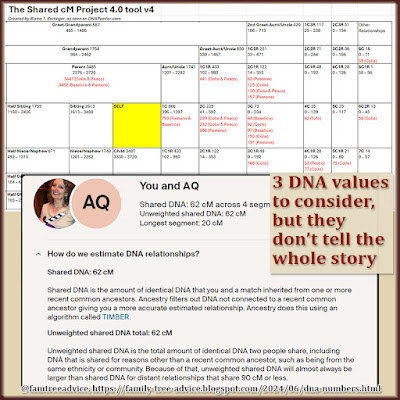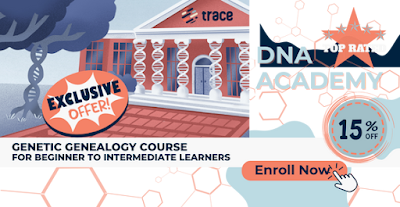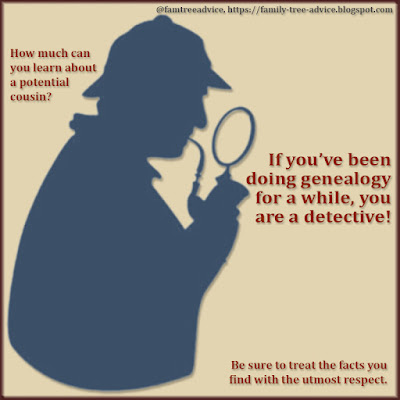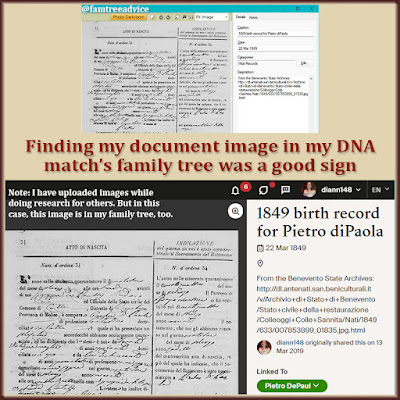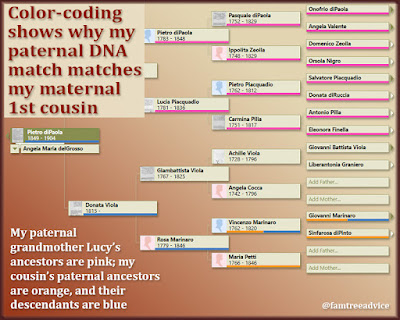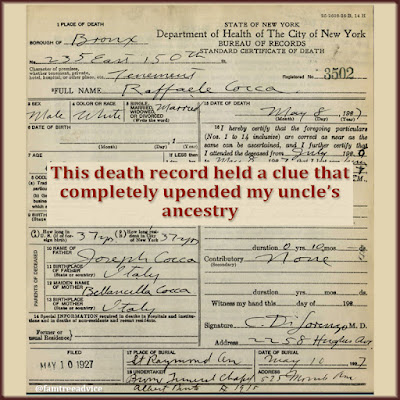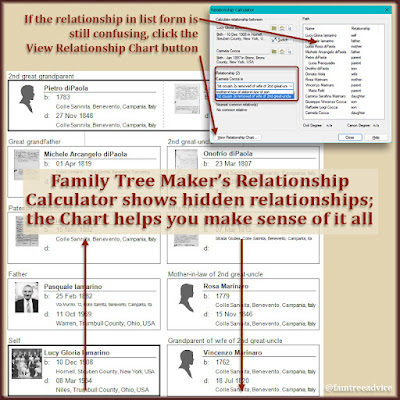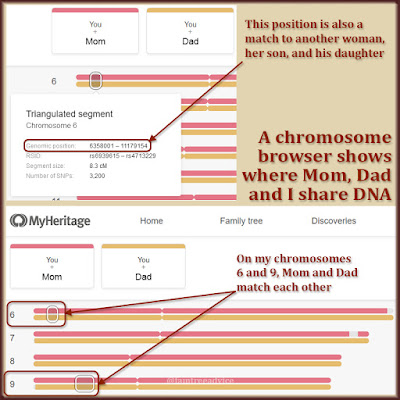I've been playing around with the chromosome browser on MyHeritage. In my DNA match list on MyHeritage, I have a woman, her father, and his mother. (They're all my AncestryDNA matches, too.) I know their roots are in the Italian hometown of my dad's family.
Their relationship to each another should look interesting on the chromosome browser. I compared them to myself and my dad and my 6th chromosome is where the action is! My dad and the woman and her father and her grandmother all intersect on two parts of my 6th chromosome.
Then I looked at my dad's DNA test. I added the 3 family members (but not myself) on his chromosome browser. I found that the 4 of them intersect on my dad's 6th and 11th chromosomes. That's a solid connection.
So here's the big question. Why does the grandmother show up in my Family Tree Maker file as "wife of 4th cousin 1x removed"? There was a ton of intermarriage in our shared ancestral hometown. So the grandmother and I have 27 different relationships in FTM, but none of them are by blood.
I've let this go unresolved for too long. It's time to bring in genealogy tools in addition to the chromosome browser.
 |
| I knew they were related to each other. A chromosome browser tied them to Dad and me. |
Tool #1: Family Tree Analyzer
A reader of this blog once told me that Family Tree Maker has a known flaw when it comes to relationships. There will be cases where it is wrong—particularly with more distant relationships. The reader suggested I defer to Family Tree Analyzer for the correct relationship.
So I opened my latest GEDCOM file in Family Tree Analyzer. I found the grandmother in the Individuals table. When I scrolled over to see the Relation to Root column, it said she's my 6th cousin once removed. Aha! So there is a true cousin connection.
Tool #2: Ancestry.com
I build my tree using Family Tree Maker and synchronize it with my tree on Ancestry.com. What a surprise to see that my Ancestry tree already knew she is my 6th cousin once removed. She's labeled as such on her profile page.
On that page I can click our relationship to see a list of generational steps from her to me.
Tool #3: Family Tree Maker
Back in Family Tree Maker, I followed those generational steps. I went from her to her father, grandfather, great grandmother, and up that paternal line until I saw it.
Way up the line, her 5th great grandparents had a yellow color code. (I use color-coding in FTM to identify my 4 grandparents' lines.) That tells me they are direct ancestors of my paternal grandfather. When I clicked their names, I saw that they are my 6th great grandparents. (Family Tree Analyzer agrees.)
Tool #4: Relationship Calculator
I wanted confirmation and to see my relationship to her son and granddaughter. (They each have more than one connection to me.) I opened my relationship calculator spreadsheet. First I went to the column for my 6th great grandparents. Then I went down that column to the row where my DNA match is this ancestor's 5th great grandchild. The column and row intersect at 6th cousin once removed.
The next 2 rows show my relationship to her son (7th cousin) and granddaughter (7th cousin once removed). Finally! I've known about these DNA matches for years without understanding our relationship.
 |
| Multiple tools pointed to one relationship. Then my color-coded family tree brought it all together. |
I did look at the Shared cM Project tool on DNA Painter to try to figure out my relationship to the grandmother. But there were too many possibilities. I also looked at the diagram of possible relationships diagram on MyHeritage. Our true relationship is too distant to show up there. Even when I compared her to my father's DNA test, it leaned toward a 3rd cousin relationship. (Thanks, endogamy.) The true relationship of 6th cousins was too far away to show.
As I mentioned, I'd already placed these 3 DNA matches in my family tree. I can take their lines back to my 8th great grandfather, born in 1671. But it always bothered me that the real picture of our relationship was hiding. Family Tree Maker does know that my 8th great grandfather is my DNA match's 7th great grandfather. But I would never have seen the true relationship without the help of other genealogy tools.
The truth is out there, as they say.


